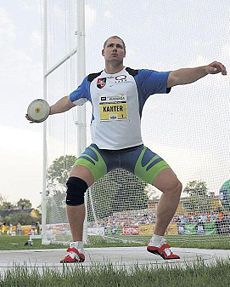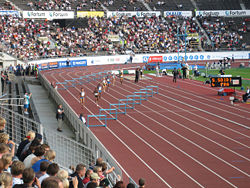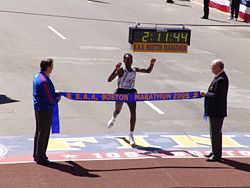Athletics (track and field)
2008/9 Schools Wikipedia Selection. Related subjects: Sports
Athletics, also known as track and field athletics, is a collection of sports events that involve running, throwing and jumping. The name is derived from the Greek word "athlos" meaning "contest".
History
The original and only event at the first Olympics in 776 BC was a stadium-length foot race or "stade", run on a track.
There were several other "games" held in Europe in the classical era:
- Panhellenic Games:
- The Pythian Games (founded 527 BC) held in Delphi every four years
- The Nemean Games (founded 516 BC) held in Argolid every two years
- The Isthmian Games (founded 523 BC) held on the Isthmus of Corinth every two years
- The Roman Games – Arising from Etruscan rather than purely Greek roots, the Roman Games deemphasized footraces and throwing. Instead, the Greek sports of chariot racing and wrestling, as well as the Etruscan sport of gladiatorial combat, took centre stage.
Other peoples, such as the Celts, Teutons and Goths who succeeded the Romans, enjoyed athletic contests. However, these were often related to combat training. In the Middle Ages the sons of noblemen would be trained in running, leaping and wrestling, in addition to riding, jousting and arms-training. Contests between rivals and friends may have been common on both official and unofficial grounds.
In the 19th century the formal organization of the modern events started. This included the incorporation of regular sports and exercise into school regimes. The Royal Military College, Sandhurst has claimed to be the first to adopt this in 1812 and 1825, but without any supporting evidence. The earliest recorded meeting was organised at Shrewsbury, Shropshire in 1840 by the Royal Shrewsbury School Hunt. There are details of the meeting in a series of letters written 60 years later by C.T. Robinson, who was a pupil there from 1838 to 1841. The Royal Military Academy at Woolwich held an organised competition in 1849, but the first regular series of meetings was held by Exeter College, Oxford from 1850.
Modern athletic events are usually organized around a 400 meter running track on which most of the running events take place. Field events (vaulting, jumping, and throwing) often take place on the infield, inside the track.
Athletics was included in the first modern Olympic Games in 1896 and has formed their backbone ever since. Women were first allowed to participate in track and field events in the 1928 Olympics.
An international governing body, the IAAF, was founded in 1912. The IAAF established separate outdoor World Championships in 1983. There are a number of regional games as well, such as the European Championships, the Pan-American Games, and the Commonwealth Games. In addition there is a professional Golden League circuit, cumulating in the IAAF World Athletics Final, and indoor championships such as the World Indoor Championships. The sport has a very high profile during major championships, especially the Olympics, but otherwise is less popular.
The AAU ( Amateur Athletic Union) was the governing body in the United States until it collapsed under pressure from advancing professionalism in the late 1970s. A new governing body called The Athletics Congress (TAC) was formed. It was later renamed USA Track and Field (USATF or USA T&F). An additional, less structured organization, the Road Runners Club of America (RRCA), also exists in the United States to promote road racing.
In modern times, athletes can receive money for racing, putting an end to the so-called " amateurism" that existed before.
Indoor track and field
There are two seasons for track and field. There is an indoor season, run during the winter and an outdoor season, run during the spring. Most indoor tracks are 200 meters and consist of four to six lanes. There are also some 150 meter indoor tracks, and others as small as 120 meters have been used. Some "oversize tracks" (larger than 200 meters) are popular for American collegiate athletics despite the fact that they are not considered valid for setting indoor records. Often an indoor track will have banked turns to compensate for the tight radius of the turns. The banking can help prevent injuries to the athlete, while also promoting higher speeds.
In an indoor track meet athletes contest the same track events as at an outdoor meet, with the exception of the 100 m and 110 m/100 m hurdles (replaced by the 55 or 60 m sprint and 55 or 60 m hurdles at most levels, or the 55 m sprint and hurdles at the high school level), the 10,000 m run, 3,000 m steeplechase, 400 m hurdles. Indoor meets also have the addition of a 3,000 m run normally at both the collegiate and elite level, instead of the 10,000 m. The 5,000 m is the longest event commonly run indoors, although there are situations where longer distances have been raced. In the mid 20th century, there was a series of "duel" races on Madison Square Garden's indoor track, some of which featured two men racing a marathon (26.2 miles). However, this is an extremely rare occurrence, for obvious reasons. In some occasions, there may also be a 500 m race instead of the open 400 m normally found outdoors, and in many college championship races indoors both are contested.
In field events, indoor meets only feature the high jump, pole vault, long jump, triple jump, and shot put (weight throw). Due to space limitations, these events take place on the infield, within the circumferential track. The longer throws of javelin, hammer and discus are added only for outdoor meets, as there is normally not enough space in an indoor stadium to house these events.
Other events unique to indoor meets (especially in North America) are the 300m, 600m, 1000m, and 35 lb (16 kg) weight throw. In some countries, notably Norway, standing long jump and standing high jump are also contested, even in the National Championships.
For multi-event athletes there is the Pentathlon for women (consisting of 60 m hurdles, high jump, shot put, long jump and 800 m) and heptathlon for men (consisting of 60 m, long jump, shot put, high jump, 60 m hurdles, pole vault and 1000 m) indoors.
Outdoor track and field
The outdoor track and field season usually begins in the spring and lasts through the summer. Most tracks are ovals of 400 meters in circumference. Modern " tartan tracks" or more recently "mondo tracks" are made with a rubberized surface; older tracks were cinder-covered. Tracks normally consist of 6-10 lanes (up to 12 lanes on the 'front' straight) and many include a steeplechase lane with a water pit on one of the turns. This steeplechase pit can be placed either inside or outside the track, making for a tighter turn or a wider turn. It is common that tracks will surround a playing field used for American football, football (soccer), or lacrosse. This inner field is usually known as the infield and has a surface of either grass or artificial turf.
All field events can be contested on the infield. However the javelin, hammer and discus throws are sometimes contested on fields outside of the track stadium because they take up a large amount of space, the implements may damage the infield, and the implements could end up landing on the track. However, some infields are used specifically for these events, and for the javelin, an athlete may have a longer run-up by starting it on the other side of the track, and crossing when there are no athletes passing.
Events
There are other variations besides the ones listed below, but races of unusual length (e.g. 300 m) are run much less often. The unusual races are typically held during indoor season because of the shorter 200 m indoor track. With the exception of the mile run, races based on imperial distances are rarely run on the track anymore since most tracks have been converted from a quarter mile (402.3 m) to 400 m; almost all record keeping for imperial distances has been discontinued. However, the IAAF record book still includes the mile world record (currently held by Hicham El Guerrouj of Morocco for men and Svetlana Masterkova of Russia for women) because of its worldwide historic significance.
Men and women do not compete against each other, although they may sometimes run in the same races due to time constraints at high school meets. Women generally run the same distances as men although hurdles and steeplechase barriers are lower and the weights of the shot, discus, javelin and hammer are less.
Track and Field is the most accessible sport for anybody to participate in. It only takes two people to have a race, or one can simply race a stopwatch. In events called All Comers Track Meets, anybody who wishes to participate is welcome, there is no exclusion because you do not have a team or even equipment. Most such meets are low cost or even free. While races are usually seeded based on the entrant's expected level of ability, the most elite of athletes can and do use these meets as training grounds.
Running Events
The following are running events conducted on a 400 meter track.
Sprints: The Sprints are events up to and including the 400 meters. Common lengths include:
- 60 meters (indoors only)
- 100 meters
- 200 meters
- 300 meters
- 400 meters (quarter mile)
Middle Distance Events: events from 600 meters to the mile. Common lengths include:
- 600 meters (indoors only)
- 800 meters (half mile)
- 1000 meters (indoors only)
- 1500 meters (metric mile)
- 1600 meters (High School mile)
Long Distance Events: events over, and including, the 3000 meters (3 k). Common lengths include:
- 3000 meters
- 3200 meters (High School 2 mile)
- 5000 meters (5 k, or approximately 3.1 miles) - most often run only at the collegiate and elite level
- 10,000 meters (10 k, or approximately 6.2 miles) - most often run only at the collegiate and elite level
In the United States, high school athletes in most states normally run the 800 m, 1600 m, and 3200 m. In a few states high school athletes run the 1500 m and 3000 m or mile and 2 mile instead of the 1600 m and 3200 m. Some people also consider the two mile distances to be middle distance events.
Hurdles: events that require the runner to jump over evenly spaced barriers during the race. Common lengths include
- 60 meter hurdles (indoors only)
- 100 meter hurdles (women)
- 110 meter hurdles (men)
- 300 meter intermediate hurdles (the usual intermediate hurdle length in middle and high school competitions)
- 400 meter intermediate hurdles (the usual intermediate hurdle length in collegiate and elite competitions)
- Steeplechase (usually 3000 meters and taking the place of the two mile distance in some competitions; one barrier per lap includes a water pit)
Relays: races in which four athletes participate as a team, passing a metal baton in between. Common lengths include:
- 4 x 100 meter relay (400 meter relay)
- 4 x 200 meter relay (800 meter relay)
- 4 x 400 meter relay (mile relay)
- 4 x 800 meter relay (2 mile relay)
Some events, such as medley relays, are rarely run except at large relay carnivals. Typical medley relays include:
- Sprint Medley Relay (SMR): the four legs are 400 meters, two 200 meter legs, 800 meters; or alternately 200 meters, two 100 meter legs, 400 meters
- Distance Medley Relay (DMR): the four legs are 1200 meters, 400 meters, 800 meters, 1600 meters
Most American high schools run the 4x100, 4x400 and 4x800, where college meets usually only include the 4x100 and 4x400. In both instances, the 4x400 is the last event at the meet.
Road Races: conducted on open roads, but often finishing on the track. Common lengths are:
- 5000 meters (5 k)
- 10,000 meters (10 k)
- Half marathon (13.1 miles)
- Marathon (26.2 miles)
- Other less common lengths include 15 k, 10 miles, 20 k, and 20 miles.
The marathon is the only common road-racing distance run in major international athletics championships, such as the Olympics.
Race Walking: usually conducted on open roads, but is also a typical event in high school meets. Common lengths are 10, 20 and 50 kilometers.
Field Events

Throwing Events:
- Discus (usually only at outdoor meets)
- Hammer Throw
- Javelin
- Shot Put
The "hammer" used for the hammer throw is different, whether the event is indoors (often a large ball, resembling a medicine ball, with a handle attached) or outdoors (basically a shot with a handle attached)
Jumping Events:
- High Jump
- Pole Vault
- Long Jump
- Triple Jump
The following events also take place, but are uncommon:
- Standing high jump
- Standing long jump
- Standing triple jump
Multiple Event Competitions
Multiple event competitions include events from both the track (running) and field events.
Pentathlon: the Pentathlon includes the following five events:
- High Hurdles (110 meters for men, 100 meters for women)
- Shot Put
- Long Jump
- High Jump
- Middle distance (1500 meters for men, 800 meters for women)
Heptathlon: the Heptathlon includes the following seven events:
Outdoors (usually only women):
- 100 meter high hurdles
- High Jump
- Shot Put
- 200 meters
- Long Jump
- Javelin Throw
- 800 meters
Indoors (usually only men):
- 60 meters
- Long Jump
- Shot Put
- High Jump
- 60 meter hurdles
- Pole Vault
- 1000 meters
Decathlon: the Decathlon includes the following ten events:
- 100 meters
- Long Jump
- Shot Put
- High Jump
- 400 meters
- 110 meter high hurdles
- Discus
- Pole Vault
- Javelin
- 1500 meters


